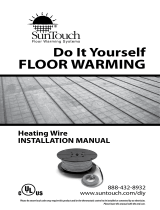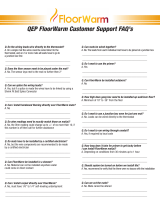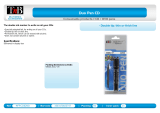
SunTouch Mat Do It Yourself Manual
13
6. Embed mats in mortar and install only under tile, stone,
brick, or other masonry surface, per this instruction
manual.
7. Never begin the mat in a shower. The connection between
the power lead and the heating wire must be fully
embedded in mortar and located at least 1' (304.8 mm)
away from shower openings and other areas normally
exposed to water.
8. Mat controls must be located at least 4' away from shower
openings. Controls cannot be exposed to water or touched
by a person while in the shower area.
9. All grout seams should be sealed after the mortar and
grout has completely cured.
10. As an option, consider installing a dedicated mat in the
shower area, separate from the rest of the floor. This will
increase control options, allowing less floor to be warmed
when the shower is not required. It will also allow for
better isolation of the shower area in the off-chance a
problem occurs.
STEP 4.10
Take photographs of the mat installation. This can be very
useful later during remodel work to help avoid possible
wire damage. Keep the photos with this installation
manual and provide to end user upon completion.
Heating Wire
Factory Splice
Shower Curb
Tile
Thinset Mortar
Notches in Shower Curb
(Minimum 1" wide, to avoid sharp
bends in cable and ensure cable is
fully embedded in mortar.)
Locate power lead and factory connection to heating wire at least
1' outside the shower area.
Phase 5: Floor Coverings
It is recommended to consult with professional flooring
installers to make sure proper materials are used and
proper installation techniques are followed. Please note,
this installation manual is not a structural or a floor covering
installation manual and is intended only for general guidance
as it applies to the SunTouch Mat product.
When installing tile or stone, the Tile Council of North
America (TCNA) guidelines, National Tile Contractors
Association (NTCA), or ANSI specifications should be followed
as a minimum standard.
A polymer-modified thin-set cement-based mortar and
grout is recommended instead of water-based multi-purpose
materials when installing a radiant product.
Do not use solvent based adhesives or pre-mix mortars
because they are not as heat resistant.
Select the proper size trowel for the installation of tile or
stone. We recommend a minimum 3/8" x 1/4" trowel. This
trowel works well for most ceramic tile. A thicker thin-set
can be used if required. Select the thin-set thickness in
accordance with the floor covering requirements.
For additional information on tile installation, please contact
TCNA at 864-646-8453 or visit their web site at www.tileusa.
com.
When installing floor coverings other than tile or stone, follow
industry and/or manufacturer’s recommendations. Ensure
the mat is first covered with a layer of self-leveling cement
based mortar, letting it cure fully before applying any surface
underlayment, floating wood or laminate flooring, carpet,
etc. The combined R-values of all floor coverings over the
mat should not exceed R-3. Higher R-values will diminish
performance. Consult the floor covering manufacturer to
verify compatibility with radiant electric heat. Also, make sure
nails, screws, or other fasteners do not penetrate the floor in
the mat area. The wire can easily be damaged by fasteners
penetrating the floor.
All floor coverings must be in direct contact with the cement-
based mortar encasing the mat. Do not elevate the floor
above the mortar mass. Do not install 2" x 4" wooden nailers
(sleepers) on top of a slab for the purpose of attaching
hardwood. Any air gap between the heating mat and the
finished floor covering will drastically reduce the overall
output of the heated floor.
Care should be taken when laying area rugs, throw rugs, and
other surface products on the floor. Most products are okay
to use, but if in doubt, consult the product manufacturer for
compatibility. Do not use rubber backed products that may
degrade or very heavy rugs that will trap heat. Be careful not
to place a rug over the area where the sensor tip was placed,
causing false thermostat readings.
When placing furniture make sure an air clearance of at least
1-1/2" is available. Furniture able to trap heat can damage the
heating system, the flooring, and the furniture over time.
Use a digital multi-meter to measure the resistance
between the conductors of the power leads again. Record
these resistances in Table 4 under “After floor coverings
are installed”.


























